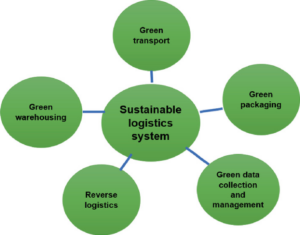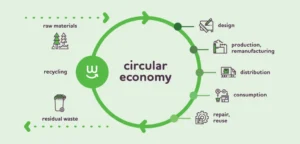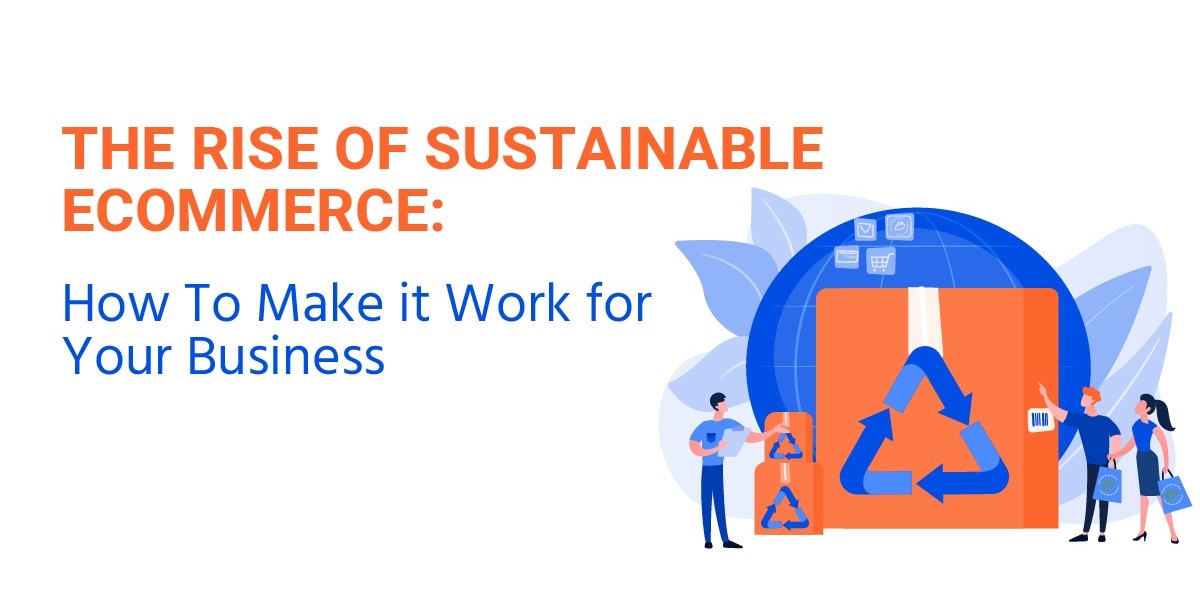As the world grapples with the daunting challenge of climate change, industries are being forced to rethink their operations and adapt to a more sustainable future. The e-commerce boom, which has brought unprecedented convenience to consumers, has also come with a hefty environmental price tag. The rapid growth of online shopping has led to a surge in packaging waste, carbon emissions, and resource depletion. However, a new wave of innovation is sweeping the logistics and e-commerce sectors, driven by a growing awareness of the need for sustainable practices. From eco-friendly packaging solutions to electric and hybrid vehicles, companies are rising to the challenge of reducing their environmental footprint. In this article, we’ll delve into the exciting developments and trends shaping the future of sustainable logistics and e-commerce, and explore how businesses are working to deliver a greener tomorrow for generations to come.
What is green logistics
Green logistics, also known as sustainable logistics or eco-logistics, is essentially the practice of minimizing the environmental impact of all the activities involved in getting a product from its origin (think raw materials) to the final customer. It’s about delivering goods efficiently, but with a strong focus on protecting the environment throughout the supply chain.
The environmental impact of e-commerce
The rapid growth of e-commerce has revolutionized the way we shop, but it has also led to a significant increase in carbon emissions, packaging waste, and transportation congestion. The last mile of delivery, in particular, is a major contributor to greenhouse gas emissions, with an estimated 30% of urban logistics-related emissions attributed to this stage. Furthermore, the rise of fast and free shipping has encouraged consumers to purchase more, leading to a surge in packaging waste and returns. The environmental impact of e-commerce is staggering, with an estimated 165 billion packages shipped worldwide in 2020 alone, resulting in millions of tons of cardboard, plastic, and other materials ending up in landfills. The transportation sector, which includes e-commerce deliveries, is also responsible for around 15% of global greenhouse gas emissions, making it a significant contributor to climate change. As the e-commerce industry continues to grow, it’s essential to address the environmental impact of online shopping and implement sustainable logistics solutions that reduce waste, emissions, and pollution.
Why go green? The advantages of green logistics
There are numerous compelling reasons for businesses to embrace green logistics practices. Here are a few key benefits:
- Reduced environmental impact: Green logistics aims to decrease greenhouse gas emissions, air and water pollution, and waste generation associated with transportation, warehousing, and packaging.
- Cost savings: Sustainable practices often translate to cost savings. Optimizing routes, utilizing fuel-efficient vehicles, and minimizing waste lead to reduced fuel consumption and operational expenses.
- Enhanced brand reputation: Consumers are drawn to brands that prioritize sustainability. Implementing green logistics demonstrates your commitment to environmental responsibility, boosting your brand image.
- Improved efficiency: Green logistics often involves optimizing processes and streamlining operations. This can lead to increased efficiency, faster delivery times, and improved customer satisfaction.
- Compliance with regulations: Environmental regulations are constantly evolving. Proactive adoption of green practices ensures compliance with current and future regulations, avoiding potential fines and legal issues.
Greening your supply chain: Strategies for sustainable logistics
There are many strategies businesses can implement to achieve greener logistics. Here are a few key areas to focus on:

- Greening the last mile
As the e-commerce industry continues to grow at an unprecedented rate, the pressure to reduce its carbon footprint has become increasingly urgent. One of the most critical areas of focus is the “last mile” – the final stage of delivery, where packages are transported from distribution centers to customers’ doorsteps. This leg of the journey is not only the most expensive but also the most polluting, with traditional gas-guzzling vehicles emitting massive amounts of CO2 and NOx into the atmosphere. However, a revolutionary shift is underway, as logistics companies and e-commerce retailers begin to adopt electric and hybrid vehicles for their delivery fleets. These eco-friendly vehicles are not only reducing greenhouse gas emissions but also operating at a significantly lower cost, making them a win-win for both the environment and the bottom line. With major players like Amazon, UPS, and FedEx already investing heavily in electric vehicle technology, the future of sustainable logistics is looking brighter than ever. As the industry continues to transition towards a greener, more environmentally friendly model, the benefits will be felt far beyond the delivery route, extending to the very planet we call home.
- Sustainable packaging solutions
As the e-commerce industry continues to boom, the environmental impact of its packaging practices has become a pressing concern. Traditional packaging materials, such as plastic bubble wrap and Styrofoam peanuts, are not only non-biodegradable but also contribute to the staggering amount of waste generated by the industry. Fortunately, innovative sustainable packaging solutions are emerging as a beacon of hope in the quest for a greener tomorrow. Eco-friendly alternatives, such as biodegradable packaging peanuts made from natural materials like cornstarch or mushroom-based packaging, are gaining traction. Additionally, companies are adopting minimalist packaging designs that reduce waste and minimize the use of harmful materials. Reusable packaging options, like cloth bags and recyclable boxes, are also becoming increasingly popular. These sustainable packaging solutions not only reduce the environmental footprint of e-commerce but also offer a unique opportunity for brands to differentiate themselves and appeal to the growing demographic of eco-conscious consumers.
- Warehousing
As the e-commerce industry continues to boom, the need for efficient and sustainable warehousing solutions has become more pressing than ever. Traditional warehouses, with their sprawling facilities and energy-hungry operations, are no longer viable in today’s eco-conscious landscape. That’s why companies are turning to innovative, green warehousing solutions to reduce their environmental footprint. Imagine a warehouse powered by renewable energy, with solar panels and wind turbines generating electricity on-site. Envision a facility that leverages cutting-edge technology, such as automated sorting systems and energy-efficient lighting, to minimize waste and optimize operations. Picture a warehouse that not only reduces its carbon emissions but also creates a healthy, productive work environment for its employees. This is the future of warehousing, and it’s arriving sooner than you think. Adopting sustainable practices, such as reducing packaging waste, implementing recycling programs, and promoting eco-friendly transportation options, companies significantly reduces their environmental impact while also improving their bottom line. The rise of sustainable logistics and e-commerce is not just a trend, it’s a necessity – and warehousing is at the forefront of this revolution.
- Supplier Selection
One crucial aspect of achieving a greener tomorrow is supplier selection. The suppliers you choose to partner with can significantly impact your carbon footprint, and ultimately, the environment. When selecting suppliers, it’s essential to consider their environmental track record, including their use of renewable energy sources, waste reduction strategies, and sustainable packaging practices. Look for suppliers who have implemented eco-friendly initiatives, such as using electric or hybrid vehicles, reducing water consumption, and minimizing landfill waste. Partner with suppliers who share your commitment to sustainability, this will significantly reduce the environmental impact of your logistics operations. Additionally, consider suppliers who offer sustainable packaging solutions, such as biodegradable or recyclable materials, to further minimize waste.
- Technology adoption
One of the key drivers of this shift towards greener logistics is the adoption of cutting-edge technology. From route optimization software to electric and hybrid vehicles, technology is playing a crucial role in reducing the environmental footprint of the logistics sector. For instance, the use of artificial intelligence and machine learning algorithms is enabling companies to streamline their delivery routes, reducing fuel consumption and lowering emissions. Additionally, the increasing use of drones, autonomous vehicles, and other alternative modes of transportation is further reducing the industry’s reliance on fossil fuels. Furthermore, the integration of Internet of Things (IoT) sensors and data analytics is providing real-time insights into logistics operations, enabling companies to identify areas of inefficiency and make data-driven decisions to minimize their environmental impact. As technology continues to evolve, it is likely that sustainable logistics will become even more efficient, cost-effective, and environmentally friendly, paving the way for a greener tomorrow.
The rise of circular economy business models

As the world shifts towards eco-friendlier and sustainable future, the concept of circular economy business models is gaining traction in the logistics and e-commerce industries. This revolutionary approach is transforming the way companies operate, by rethinking the traditional linear model of “take, make, dispose” and instead adopting a circular model that prioritizes the reuse, recycling, and upcycling of resources. In this new paradigm, companies are redesigning their supply chains to be more closed-loop, where products are designed to be recycled, refurbished, or biodegradable, and waste is minimized or eliminated altogether. This not only reduces the environmental footprint of businesses but also opens up new revenue streams and opportunities for growth. With the rise of circular economy business models, companies are now able to reduce their carbon footprint, decrease waste, and increase customer loyalty, all while staying ahead of the competition in a rapidly changing market.
Case studies: Companies leading the way in sustainable logistics and e-commerce
A growing number of companies are recognizing the importance of adopting sustainable logistics practices to reduce their environmental footprint. Several trailblazing companies are leading the way in this movement, setting a new standard for environmentally responsible operations. Take, for example, Patagonia, the outdoor apparel brand that has made a commitment to using 100% renewable energy in its distribution centers. By investing in solar and wind power, Patagonia has reduced its carbon emissions by a staggering 60%. Another company making waves in sustainable logistics is IKEA, which has implemented a fleet of electric and hybrid vehicles to reduce its reliance on fossil fuels. Meanwhile, online retail giant, Amazon, is investing heavily in its “Fulfillment by Amazon” (FBA) program, which aims to reduce packaging waste and increase the use of recyclable materials. These companies, and others like them, are demonstrating that it is possible to balance business growth with environmental responsibility, paving the way for a more sustainable future in e-commerce and logistics.
Resources for green logistics implementation
- The Council of Supply Chain Management Professionals (CSCMP): https://cscmp.org/ offers a wealth of resources on sustainable logistics practices.
- The Environmental Protection Agency (EPA): https://www.epa.gov/ provides information and tools to help businesses reduce their environmental impact.
- The Green Supply Chain Alliance (GSCA): https://www.thessca.org/ is a non-profit organization dedicated to promoting sustainable supply chain practices.
Conclusion
As the world grapples with the challenges of climate change, environmental degradation, and social responsibility, the e-commerce industry has a critical role to play in shaping a more sustainable future. The rise of sustainable logistics and e-commerce is a beacon of hope, offering a pathway to reduce carbon footprint, minimize waste, and promote eco-friendly practices. Embracing innovative technologies, collaborative partnerships, and customer-centric approaches, businesses can not only mitigate their environmental impact but also reap the benefits of increased efficiency, reduced costs, and enhanced brand reputation. As we look to the future, it is clear that the marriage of sustainability and e-commerce is no longer a nicety, but a necessity.

